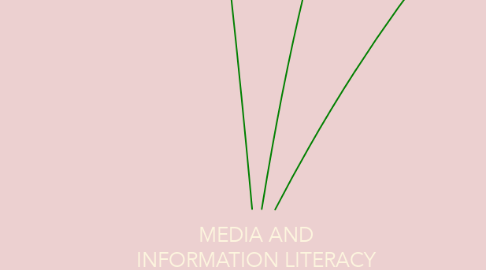
1. Lesson 2 : Media Then and Now
1.1. BRIEF HISTORY OF MEDIA
1.1.1. PRE INDUSTRIAL AGE
1.1.1.1. cave paintings
1.1.1.2. clay tablets
1.1.1.3. dibao
1.1.1.4. popyrus
1.1.1.5. codex
1.1.1.6. acta diurna
1.1.2. INDUSTRIAL AGE
1.1.2.1. newspaper
1.1.2.2. typewriter
1.1.2.3. photography
1.1.2.4. printing press
1.1.2.5. motion picture
1.1.2.6. telegraph
1.1.2.6.1. large electronic computers
1.1.2.7. punch card
1.1.3. ELECTRONIC AGE
1.1.3.1. TV
1.1.3.2. Personal computer
1.1.3.3. mainframe computer
1.1.3.4. LCD projectors
1.1.3.5. transistor radio
1.1.4. DIGITAL AGE
1.1.4.1. blogs
1.1.4.2. social networks
1.1.4.3. web browsers
1.1.4.4. video / youtube
1.1.4.5. search engines
1.1.4.6. smart phones
1.1.4.7. video chat / skype
1.2. Brief History of Philippine Media
1.2.1. coincides with the colonial history of the nation
1.2.1.1. political movements
1.2.1.2. upheavals
2. Lesson 3 : Understanding Media: Aesthetics of the Image, Text and Audio
2.1. Framing - means to construct, compose or imagine something, meaning to create a solid plan to follow using a specific structure in mind
2.1.1. Framing and Reading
2.1.1.1. - this is where form and content should be taken into consideration - and always together - when we deconstruct and later construct media and media products
2.2. Newspaper and Journalism
2.2.1. Newspaper - a regularly scheduled publication containing news, information and advertising
2.2.1.1. Sections Inside
2.2.1.1.1. the general category of headline / most important news of the day
2.2.1.1.2. opinions
2.2.1.1.3. entertainment
2.2.1.1.4. lifestyle
2.2.1.1.5. technology
2.2.1.1.6. sports
2.2.1.2. Structures
2.2.1.2.1. 5Ws & 1H
2.2.1.3. Newspaper format
2.2.1.3.1. Tabloid
2.2.1.3.2. Broadsheet
2.2.2. Journalism - the collecting, writting, editing and presenting of news in newspapers, magazines, radio and television broadcasts or the internet
2.2.2.1. without any form of bias or emotion
2.3. BOOKS, COMICS, MAGAZINES AND THE PUBLISHING INDUSTRY
2.3.1. TYPES OF BOOK
2.3.1.1. texboook
2.3.1.2. literary titles
2.3.1.3. Comics
2.3.1.4. Picture books
2.3.1.5. Travel books
2.3.2. COMICS
2.3.2.1. Marvel
2.3.2.2. DC Comics Universe
2.3.3. NOVEL
2.3.3.1. The Fault in our Stars
2.3.4. MAGAZINE
2.3.4.1. Cosmopolitan
2.3.4.2. Time Magazine
2.3.5. Publication
2.3.5.1. Publishing a book depends on what the audience wants and might get their interest
2.3.5.2. Most Publishing Houses cover a wide range of publications to earn more profits and address specific sector's needs
2.4. PHOTOGRAPHY AND TIMLESS IMAGE CONCEPT
2.4.1. Elements to Consider
2.4.1.1. Absence of Colors
2.4.1.2. Lighting and Focus
2.4.1.3. Shadows and Highlight
2.4.1.4. Depth
2.4.1.5. Balance of Elements
2.4.2. Photography
2.4.2.1. " The process of recording images through a chemical reaction cause by light rays hitting a sensitized surface
2.4.3. Questions to be considered
2.4.3.1. Where is the camera located? Is it near or far from the object.
2.4.3.2. Where is the camera place? Is it higher or lower than the object
2.4.3.3. What is the main focus?
2.5. FRAMING AND LISTENING
2.5.1. Radio Evoking Imagination
2.5.1.1. Background in our life
2.5.1.1.1. When we listen, our hands could be busy making crafts, fixing things or do chores
2.5.1.2. Interactive Media
2.5.1.2.1. Reach
2.5.1.2.2. Flexibility
2.5.1.2.3. Accessibility
2.5.1.2.4. Ability to leave something on the imagination
2.5.1.3. It is for all even illiterate person can listen to it. Unlike newspaper, you have the ability to read to understand what's on it
3. written or print media
4. Lesson 1: What is Media?
4.1. DEFINING MEDIA
4.1.1. Helps us spread information in different forms and devices
4.1.2. Message is crafted into information which is carried and disseminated through the media
4.2. THE COMMUNICATION PROCESS
4.2.1. (S) Sender or Source - you, the one who had an idea to share
4.2.2. (M) Message - from the source & relayed as a piece of information.
4.2.3. (C) Channels - thing used to spread your message such as megaphone or microphone
4.2.4. (R) Receiver - people who receive or listen to your information
4.2.5. The "SMCR Model"
4.3. FEEDBACK MECHANISM
4.3.1. SHANNON & WEAVER LINEAR OF COMMUNICATION (1949)
4.4. INFORMATION INDUSTRY
4.4.1. CREATIVE INDUSTRY
4.4.1.1. FILM
4.4.1.2. BROADCAST
4.4.1.3. PUBLISHING
4.4.1.4. PHOTOGRAPHY
4.5. MEDIA AS A CULTURE OF ENTERTAINMENT
4.5.1. Culture - the sum of those characteristics that identify and differentiate human societies - a complex interwave of many factors
4.5.1.1. Pop Culture
4.5.1.1.1. high culture or high art
4.5.1.1.2. low brow
4.6. KINDS OF MEDIA
4.6.1. TRADITIONAL MEDIA
4.6.1.1. broadcast media
4.6.1.2. film or cinema
4.6.1.3. used to disseminate a piece of information to a large audience
4.6.2. NEW MEDIA
4.6.2.1. Information and Communication Technology (ICT)
4.6.2.2. Mobile Technology
4.6.2.3. "Digital Media"
4.6.3. SOCIAL MEDIA
4.6.3.1. facebook
4.6.3.2. Instagram
4.6.3.3. twitter
4.6.4. Example
4.6.4.1. Cellular phone
4.6.4.2. Tablet
4.6.5. MOBILE COMMUNICATION TECHNOLOGY
4.6.5.1. Inside of it
4.6.5.1.1. Data
4.6.5.1.2. Internet
4.6.5.2. one stop shop of traditional & new media tech combined
